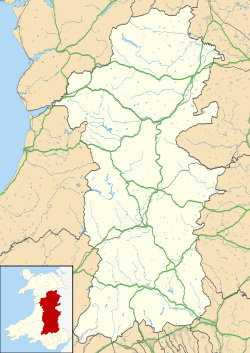Powys is the largest administrative county in Wales. With an over a quarter of Wales's land area, covering much of the eastern half of the country, it is a county of remote uplands, low population and no coastline. It was created in more or less its current form in 1974, and is the only one of the large county units created at that time to have been carried forward intact at the 1996 local government re-organisation. It comprises three historic counties, namely Montgomeryshire, Radnorshire, and most of Brecknockshire. There are 950 Scheduled monuments within the county, which is far more than can be sensibly covered in one list. Each of the 3 historic counties is therefore listed separately, and each of these has two lists - one for the prehistoric sites and one for the Roman, medieval and post-medieval sites.
Contents
This list shows the sites dating to Roman, medieval and post-medieval times in Radnorshire, which occupies the central third of Powys. The River Wye separates it from Brecknockorshire to the south, and Montgomeryshire forms the northern third of Powys. Of the 258 Scheduled monuments in Radnorshire, 139 date to prehistoric times. The 119 on this list include 14 Roman sites, all related to the military occupation of Wales. The 14 Early Medieval sites are mostly sections of Offa's Dyke, but also include two inscribed stones. The 82 medieval sites are overwhelmingly defensive structures, particularly mottes, but also including castles, settlements, town defences and an Abbey. Of the nine post-medieval sites, only one is industrial, with five abandoned settlements and three World War II structures.
The lists of Scheduled Monuments in Powys are as follows:-
- List of Scheduled prehistoric Monuments in Powys (Brecknockshire) (254 sites)
- List of Scheduled Roman to modern Monuments in Powys (Brecknockshire) (135 sites)
- List of Scheduled prehistoric Monuments in Powys (Radnorshire) (139 sites)
- List of Scheduled Roman to modern Monuments in Powys (Radnorshire) (119 sites - shown below)
- List of Scheduled prehistoric Monuments in Powys (Montgomeryshire) (190 sites)
- List of Scheduled Roman to modern Monuments in Powys (Montgomeryshire) (113 sites)
Scheduled Ancient Monuments (SAMs) have statutory protection. It is illegal to disturb the ground surface or any standing remains. The compilation of the list is undertaken by Cadw Welsh Historic Monuments, which is an executive agency of the National Assembly of Wales. [1] The list of scheduled monuments below is supplied by Cadw [2] with additional material from RCAHMW and Clwyd-Powys Archaeological Trust.





